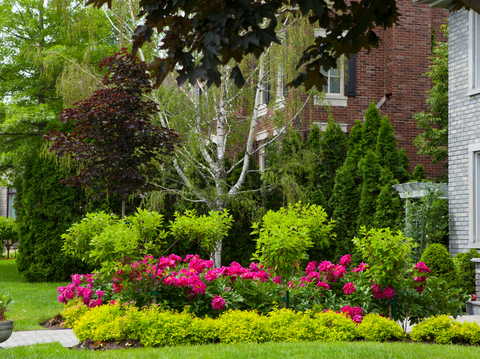Tree Care Guide: Your Friendly Path to Thriving Plants - Simply Trees
Welcome to Simply Trees' tree care guide! Trees are more than just pretty additions; they're vital to our planet. They clean the air, provide shade, and offer homes to wildlife—all while adding a peaceful vibe to your space.
In this guide, we'll share essential plant care instructions and gardening tips to help your trees flourish. Whether you're a green thumb guru or just starting your gardening journey, our tips will make tree care easy and enjoyable. For more on how trees benefit the environment, check out the Benefits of Trees and Vegetation from the US EPA.
Understanding Your Tree's Needs
Trees come in various shapes and sizes, each with unique care requirements. Here's how to ensure healthy growth:
• Types of Trees: From majestic oaks to delicate cherry blossoms, every tree species has its own needs. Some love the sun, while others prefer shade. Explore our collection of trees to find your perfect match.
• Climate Considerations: Your local climate affects tree health. Tropical trees may struggle in cold areas, so choose wisely.
• Soil Type: Soil impacts water drainage and root growth. Sandy soil drains fast, while clay retains moisture longer.
Keep these factors in mind when selecting trees to create a landscape that's both beautiful and sustainable.
Plant Care Instructions for Healthy Growth
Watching your trees thrive is rewarding. Here's a simple guide to help your plants grow strong and healthy:
• Planting: Choose a spot with enough room for growth. Dig a hole twice as wide and as deep as the root ball. Place the tree in the hole, level the root ball with the ground, fill with soil, and water thoroughly to remove air pockets.
• Watering: Young trees need regular watering to establish roots. Water deeply once a week, letting the soil dry slightly between sessions. Mature trees may need less frequent watering, depending on climate and soil type.
• Sunlight: Most trees love full sun, but some prefer partial shade. Check your tree's sunlight needs.
• Soil Quality: Good soil is key. Ensure it's well-draining and rich in organic matter. Enhance soil quality with compost or well-rotted manure.
• Mulching: Apply a 2-3 inch layer of mulch around the tree base, avoiding the trunk. Mulch retains moisture, regulates temperature, and suppresses weeds.
• Fertilizing: Use balanced, slow-release fertilizer in early spring for nutrients. Avoid over-fertilizing to prevent harm.
Routine Maintenance Tips for Healthy Plants
Regular maintenance keeps your trees in top shape. Follow these plant maintenance tips:
• Pruning: Prune during the tree's resting period to remove dead or diseased branches, encouraging healthy growth and better shape.
• Mulching and Watering: Adjust watering based on the season. Increase frequency during dry spells.
• Seasonal Care: Adapt your routine with the seasons. Protect young trees from frost in winter and check for new growth in spring.
• Pest and Disease Control: Regularly inspect trees for pests and diseases. Catching issues early prevents serious damage. For more on tree pests and diseases, visit Woodland Trust.
These tips ensure your trees remain vibrant, adding beauty and value to your garden.
Gardening Tips for a Flourishing Landscape
Creating a stunning garden goes beyond planting trees. Here are some gardening tips for a vibrant landscape:
• Balance and Aesthetics: Arrange plants to balance colors, heights, and textures, creating visual interest and harmony.
• Diversity is Key: Mix trees, shrubs, and flowers to boost biodiversity, supporting local wildlife and strengthening your garden against pests and diseases.
• Embrace Native Plants: Native plants adapt to local climate and soil, making them easier to care for. They also support native wildlife. Learn more about native plants from Audubon.
Troubleshooting Common Tree Problems
Even with the best care, trees can face challenges. Here's how to tackle common issues:
• Pests: Look for signs like holes in leaves or drooping. Use natural pest control, like beneficial insects or neem oil.
• Diseases: Fungal issues cause discolored leaves or bark. Prune affected areas and apply fungicides if needed.
• Nutrient Deficiencies: Yellowing leaves may signal nutrient lack. Test soil and amend with necessary fertilizers.
By addressing these problems, you can keep your trees healthy and strong.
Sustainable Practices in Tree Care
Tree care is about more than aesthetics; it's about being kind to our planet. At Simply Trees, we embrace sustainability to keep trees healthy and happy. Here are some eco-friendly tips:
• Composting: Turn kitchen scraps and yard waste into nutrient-rich compost—it's natural fertilization and waste reduction.
• Water Conservation: Use rain barrels to collect rainwater for plants, saving water and ensuring trees get what they need.
• Natural Pest Control: Encourage beneficial insects like ladybugs and lacewings to manage pests without harmful chemicals.
Simply Trees is committed to sustainability, from direct-from-farm fulfillment to eco-friendly packaging. By choosing us, you're supporting a greener future.
Wrap-Up and Next Steps
We've covered a lot in this tree care guide, from understanding your tree's needs to practicing sustainable care. Here are the key takeaways:
• Know your tree and its specific requirements for healthy growth.
• Regular maintenance like pruning and watering is crucial for plant health.
• Incorporate native plants and eco-friendly practices for a thriving, sustainable garden.
Ready to elevate your garden? Explore our range of outdoor trees and house plants to find the perfect addition to your landscape. Whether you're a novice or a seasoned gardener, Simply Trees is here to help. For personalized advice and support, reach out to our friendly customer care team. Let's grow something beautiful together!


